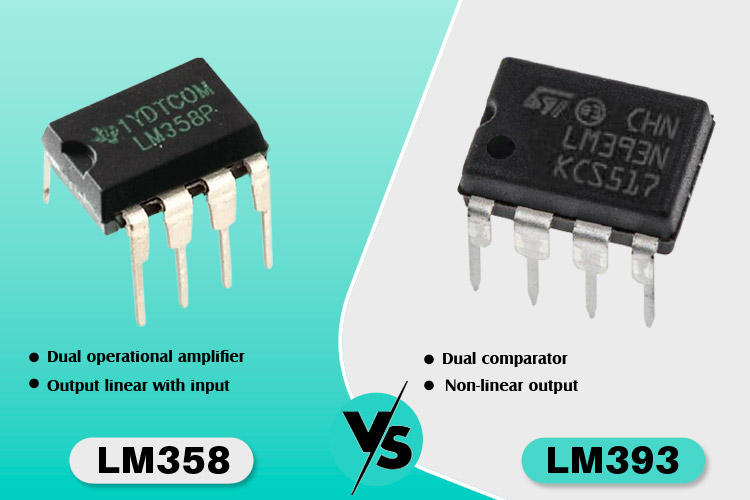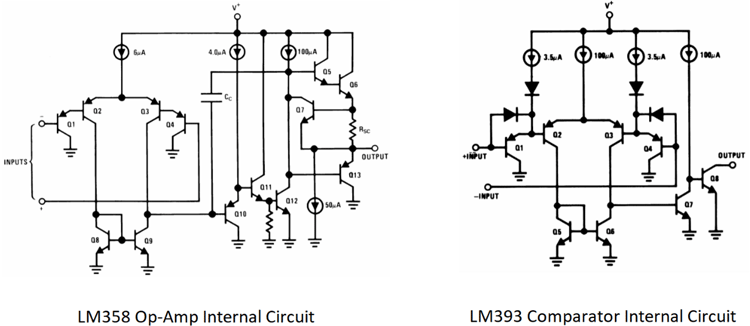Arduino UNO Q bridges high-performance computing with real-time control.
LM393 Dual Comparator vs LM358 Dual Op-Amp

The LM358 Op-Amp and the LM393 Comparator are two common jellybean components that are characterized by their ease of use and availability. Outwardly, the LM358 and LM393 are very similar – they come in the same package and with the same pinout, but there are fundamental differences to both chips, which we will be taking a look at in this article.
Specifications Of LM358 and LM393
|
Specification |
LM358 |
LM393 |
|
Supply Voltage |
32V, +/-16V |
36V, +/-18V |
|
Differential Input Voltage |
32V |
36V |
|
Input Offset Voltage |
3mV max. |
5mV max. |
|
Input Bias Current |
100nA max. |
250nA max. |
|
Input Common Mode Range |
0V to V+ - 2V |
0V to V+ - 1.5V |
|
Large Signal Voltage Gain |
100V/mV typ. |
200V/mV typ. |
|
Bandwidth |
1MHz |
Not specified |
Although the input specifications seem similar, it is clear that the LM358 Op-Amp has a lower bias current and offset voltage, since it is designed to be used as an amplifier where these parameters matter. On the other hand, the LM393 has slightly worse input bias and offset performance, because for a comparator these parameters are not usually critical, since it is designed to be used only to compare voltages and not amplify them.
This is also reflected in the large signal voltage gain. The op-amp has a smaller gain, whereas the comparator’s gain is much higher to make the output transition as fast as possible. The bandwidth of the comparator is also not specified, since it is not compensated.
Note: More technical details can be found in the LM358 datasheet and LM393 datasheet linked at the bottom of this page.
Taking A Look at Internal Circuitry of LM358 and LM393

FIG. LM358 AND LM393 INTERNAL CIRCUIT
At first glance, the internal circuits of the LM358 and the LM393 look similar, but taking a closer look we can find the differences that explain the different specifications mentioned above.
The input stages are similar to “Darlington-connected” PNPs, which explains the ground sensing capability of both the LM358 and LM393. The differential stages run at different currents, however – the LM393 runs at a higher current to increase the gain and output switching speed. Since the LM358 is a linear amplifier, this is not so important.
The largest difference is the output stages. The output stage of the LM393 is much simpler than that of the LM358 because it is designed to switch the output between the rails as fast as possible, spending the smallest amount of time between the rails. The output stage is also open-collector. The LM358 has a fully linear output stage, since it is an op-amp and designed to be used as a linear amplifier, where the output scales linearly with the input.
Major Differences Between LM358 and LM393
|
LM358 |
LM393 |
|
Dual operational amplifier |
Dual comparator |
|
Relatively better input specifications |
Relatively worse input specifications |
|
Output linear with input |
Non-linear output |
|
Stable with negative feedback |
Stable with positive feedback |
Conclusion
The LM358 and LM393 might seem outwardly similar, but the LM358 is an operational amplifier with linear output, and the LM393 is a comparator with a digital output, and they cannot be interchanged.









